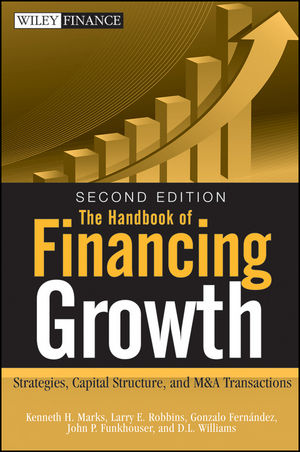“Once again, Kenneth Marks and company have hit the mark with a comprehensive analysis of corporate and commercial finance, which is both readable and up-to-date. This book is a must for any entrepreneur, middle-market company CFO, or graduate student looking for a thorough presentation of real world financial solutions. I highly recommend it.”
—Barry D. Yelton, Senior Vice President and Region Manager, Federal National Payables, Inc.
“This is a valuable tool to anyone raising capital. I’ve seen firsthand how the current environment is filled with dead ends for those seeking to grow their business. Having a blueprint for the process will save time and resources; two things any growth company can ill afford to spend. By looking at the process and explaining the various components of how capital forms, the authors provide necessary insight toward a productive effort. Anyone considering a capital raise should embark on that journey with this resource.”
—Christopher Gaertner, Head of Technology Investment Banking, Managing Director, Merrill Lynch
“All principals involved in financing their growth should keep a copy of this book handy and refer to it frequently for guidance. It provides clear guidelines and case studies that can be used by any of the 27 million firms in the U.S. that want to grow.”
—James F. Smith, PhD, Chief Economist, Parsec Financial Management
“Ken Marks and team have done a great service here to top management of middle-market companies, their advisors, as well as the investment community in understanding growth financing. This book is a perfect combination of being comprehensive (the glossary alone contains over 650 terms) yet very understandable. Too bad that more books written on this subject aren’t written the way this one is.”
—Bob Grabill, President and CEO, Chief Executive Network
“I am enthusiastic about this Second Edition of The Handbook of Financing Growth. The authors have updated chapters throughout and introduced a very useful, ‘new project leadership’ tool in Chapter 2. I can’t imagine a more complete business financing guide. And, because of the tremendous amount of business wisdom contained herein, this book is valuable for its general business planning guidance alone. Highly recommended; a copy belongs in every entrepreneur’s library!”
—Peter Pflasterer, entrepreneur and founder, JPS Communications, Inc.
“Considering the many financing challenges in the midst of our global recession, as a leading trade association for M&A professionals, we believe the new edition of The Handbook of Financing Growth is essential reading for any business owner, advisor, or investor. This ambitious sharing of ‘hands on’ experiences will surely prove to be very rewarding for any decision maker in the private capital marketplace today!”
—Michael R. Nall, CPA, CM & AA, and founder, Alliance of M&A Advisors
Table of Contents
Foreword.
Preface.
Acknowledgments.
About the Authors.
PART I The Financing Process.
Chapter 1 Introduction.
Chapter 2 Planning and Alignment (Begin with the End in Mind).
An Overview of the Planning Process.
Strategic Planning.
Updated Forecast.
Business Valuation.
Chapter 3 Acquisitions, Recapitalizations, and Exits.
Acquisitions.
Selling the Company, Creating Shareholder Liquidity.
Chapter 4 Capital Structure and Financing Strategy.
Assimilating the Drivers.
Developing Liability Limits.
Chapter 5 Sources of Capital and What to Expect.
Bootstrapping Sources and Techniques.
Individual Investors (Private Placements Not from Angels or Institutions).
Angel Investors.
Commercial Banks.
Asset-Based Lenders.
Commercial Finance Companies.
Leasing Companies.
Private Equity.
Venture Capital Funds.
Mezzanine Funds.
Buyout Funds.
Hedge Funds.
Strategic or Industry Investors—Corporate Venture Capital.
Merchant Banks.
Community Development Initiatives and Government Agencies.
Micro-Cap Public Entities.
Royalty Financing.
Chapter 6 Equity and Debt Financings: Documentation and Regulatory Sources of Capital and What to Expect.
Basic Definition of Debt and Equity.
Debt Instruments.
Loan Documentation.
Equity Instruments.
Equity Investment Documentation.
Compliance with Securities Laws.
Chapter 7 Expert Support—The Players and Their Roles.
Counsel.
Board of Directors.
Investment Bankers.
Accountants.
Consultants/Advisers.
Summary.
Chapter 8 Closing the Deal.
Process Check-in.
Final Perspective.
PART TWO Case Studies.
Case Study 1 Asset-Based Lender, Receivables Financing.
Case Study 2 Asset-Based Lender, High Risk Loan.
Case Study 3 Asset-Based Lender, Assignment for Benefit of Creditors.
Case Study 4 Asset-Based Lender, Acquisition.
Case Study 5 Asset-Based Lender, Turnaround Funding.
Case Study 6 Asset-Based Lender, Growth Financing.
Case Study 7 Commercial Finance, Trade Financing.
Case Study 8 Angel Investor, Initial Funding and Sale of Company.
Case Study 9 Venture Capital, Early Stage Growth Equity.
Case Study 10 Royalty Financing.
Case Study 11 Venture Capital, Growth Equity.
Case Study 12 Community Development Finance, Growth Funding.
Case Study 13 Debt with Revenue Sharing.
Case Study 14 Mezzanine Investment.
Case Study 15 Private Equity, Acquisition through Exit.
Case Study 16 Private Equity, Management Buyout / Partner Exit.
Case Study 17 Private Equity, Restructuring.
Case Study 18 Private Equity, Acquisition with Management Participation.
Case Study 19 Private Equity, Public to Private Transaction.
Case Study 20 Private Equity, Buy-and-Build Strategy.
PART THREE Financing Source Directory.
Suggested Use of the Directory Section.
APPENDIX A Corporate Finance Primer.
APPENDIX B : Financial Statements.
APPENDIX C Discount Rates.
APPENDIX D How Fast Can Your Company Afford to Grow?
APPENDIX E Notes about Start-Ups.
APPENDIX F Accounting Principles—GAAP and IFRS.
Glossary.
Notes.
Index.




